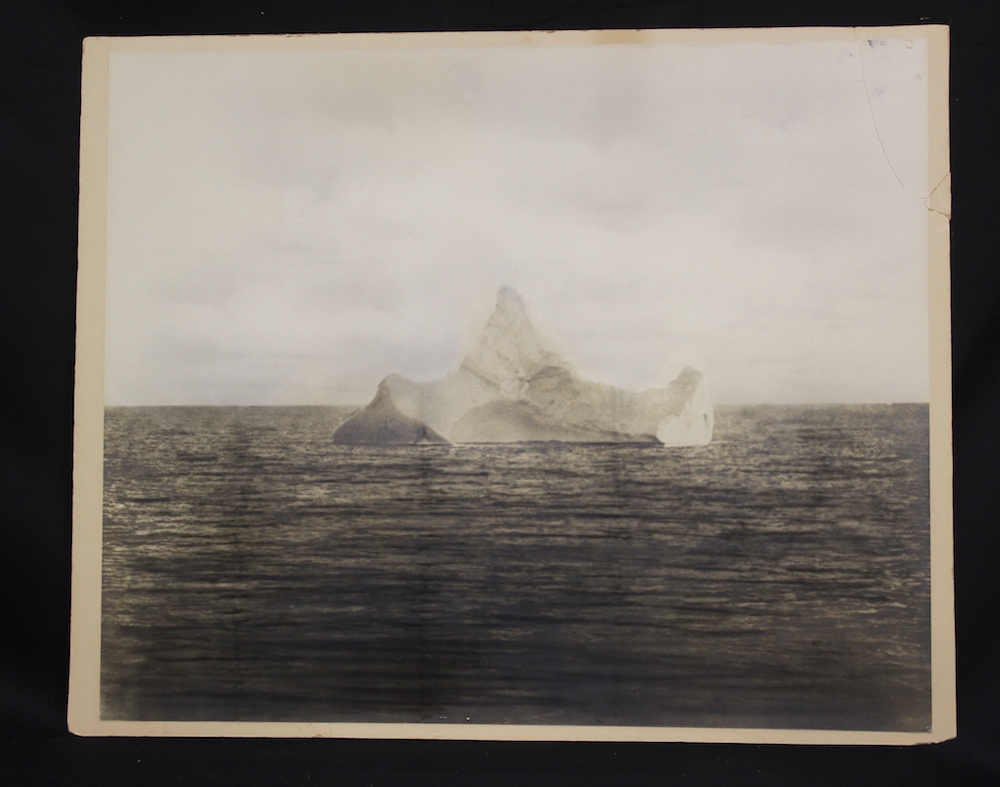Photo of Iceberg that Sank Titanic for Sale: Is It Real?

A photo of what could be the notorious iceberg that sunk the Titanic is up for auction this weekend, but experts are unsure whether the historic snapshot actually shows the destructive iceberg, or simply one that was floating in the vicinity at the time of the accident.
The "unsinkable" RMS Titanic departed on its maiden voyage on April 10, 1912. It sunk days later when it hit an iceberg at 11:40 p.m., about 400 miles (644 kilometers) south of Newfoundland, on April 14. More than 1,500 of the roughly 2,200 passengers onboard died in the disaster.
On the morning of April 15, the SMS Prinz Adalbert liner passed by the site. The liner's chief steward took a photo of an iceberg with three crownlike points and an odd red streak on it, possibly from the Titanic's hull, he wrote in a note accompanying the photograph. [Image Gallery: Stunning Shots of the Titanic Shipwreck]
"On the day after the sinking of the Titanic, the steamer Prinz Adalbert passes the iceberg shown in this photograph," the chief steward wrote in a message to commemorate the event. "The Titanic disaster was not yet known by us. On one side red paint was plainly visible, which has the appearance of having been made by the scraping of a vessel on the iceberg. SS Prinz Adalbert Hamburg America Line."
The chief steward and three other crewmen signed the message, said Andrew Aldridge, an auctioneer and valuer with Henry Aldridge and Son, the company handling the auction.
Hamburg America Lines originally gave the photo to its attorneys, Burlingham, Montgomery & Beecher, when it learned that the firm would be defending the Titanic's company, White Star Line, in court. The photo hung in the firm's office for nearly 90 years, from 1913 until 2002, when the firm closed.
Iceberg mystery
Sign up for the Live Science daily newsletter now
Get the world’s most fascinating discoveries delivered straight to your inbox.
However, this isn't the only photo that could show the Titanic's iceberg.
"There are two photos of icebergs from the area on the day following the collision, both of which purport to be the Titanic iceberg," said Grant Bigg, an environmental scientist at the University of Sheffield in England.
In 2014, Bigg co-wrote a study about the number of icebergs floating in the Atlantic Ocean in 1912. Common lore suggested that the Atlantic was littered with an unusually high number of icebergs during the spring of 1912, but by studying old Coast Guard records, the researchers found that 1912 was an average year for dangerous floating ice.
Moreover, it's likely that the fatal iceberg came from one of Greenland's southern glaciers, Bigg discovered.
During his research, Bigg learned about the two iceberg photos. The other, taken by Captain William George Squares de Carteret of the SS Minia, is from a U.S. Coast Guard archive, he said.
Surviving passengers who saw the deadly iceberg later gave its approximate dimensions. These reports roughly match the dimensions of the iceberg in Carteret's photo, measuring about 394 feet long by 98 feet high (120 m by 30 m), Bigg said.
"I personally think the Carteret photo is the more likely candidate," largely because of the shape and dimensions, Bigg told Live Science.
Aldridge agreed that there's "no definitive answer" about which iceberg is the true culprit. "What's interesting with this one is the provenance of the lot," he said, referring to the photo's accompanying note, the evidence of the red streak and its history with Hamburg America Lines and White Star Line.
Henry Aldridge and Son is auctioning the photo on Saturday (Oct. 24). It's expected to fetch between $15,000 and $20,000, Aldridge said.
Follow Laura Geggel on Twitter @LauraGeggel. Follow Live Science @livescience, Facebook & Google+. Original article on Live Science.

Laura is the archaeology and Life's Little Mysteries editor at Live Science. She also reports on general science, including paleontology. Her work has appeared in The New York Times, Scholastic, Popular Science and Spectrum, a site on autism research. She has won multiple awards from the Society of Professional Journalists and the Washington Newspaper Publishers Association for her reporting at a weekly newspaper near Seattle. Laura holds a bachelor's degree in English literature and psychology from Washington University in St. Louis and a master's degree in science writing from NYU.
Why is yawning contagious?
Scientific consensus shows race is a human invention, not biological reality









